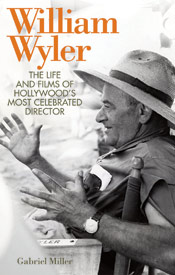(The University Press of Kentucky, 520 pages, $35.95)
By Gabriel Miller
 His record remains unmatched. William Wyler is the most decorated director in the history of the Academy Awards (an unprecedented 12 Oscar nominations, and three wins) and directed more Oscar-winning actors than anyone else. Wyler’s longevity—he worked continuously from 1925 through 1970—and mastery of multiple genres makes it difficult to put a label on him. From war dramas like The Best Years of Our Lives (1946), to the grand biblical epic Ben-Hur (1959) and romantic comedies like Roman Holiday (1953), Wyler’s work was among the most popular and successful of his time. Among some critics, his eclecticism has contributed to a reputation as a craftsman in the service of a product, rather than a visionary. With no obvious gimmicks to identify his films as distinctly “Wyler-esque,” he has often been excluded from auteurist circles, and by extension from serious film study, which, as Gabriel Miller argues in William Wyler: The Life and Films of Hollywood’s Most Celebrated Director, is a gross oversimplification.
His record remains unmatched. William Wyler is the most decorated director in the history of the Academy Awards (an unprecedented 12 Oscar nominations, and three wins) and directed more Oscar-winning actors than anyone else. Wyler’s longevity—he worked continuously from 1925 through 1970—and mastery of multiple genres makes it difficult to put a label on him. From war dramas like The Best Years of Our Lives (1946), to the grand biblical epic Ben-Hur (1959) and romantic comedies like Roman Holiday (1953), Wyler’s work was among the most popular and successful of his time. Among some critics, his eclecticism has contributed to a reputation as a craftsman in the service of a product, rather than a visionary. With no obvious gimmicks to identify his films as distinctly “Wyler-esque,” he has often been excluded from auteurist circles, and by extension from serious film study, which, as Gabriel Miller argues in William Wyler: The Life and Films of Hollywood’s Most Celebrated Director, is a gross oversimplification.
The narrative of this insightful work is biographical—albeit deeply craft-oriented—and Miller is at his best when he dedicates himself to examining the artistry of Wyler’s direction. Wyler’s life provides the framework for Miller to explore the director’s exhaustive canon in intricate detail, with frame-by-frame analysis. The text is fluid and accessible, even when delving into technical matters. Miller ably examines the elements that made Wyler’s films so powerful: his signature deep focus photography, sense of time and space, and humanist subject matter. Miller makes a strong case that when it comes to conveying ideas visually, Wyler is a master strategist.
Wyler, who entered the business in 1920 through family connections, as so many did in the early studio days, had, by 1925, directed his first two-reeler. He was quick to prove his worth as a major industry force, and eventually became Samuel Goldwyn’s director of choice, helming for him Dead End (1937) and Wuthering Heights (1939), among others. But he was far from a cog in the studio machinery. As a fiercely independent, principled director, Wyler frequently butted heads with his studio bosses due largely to his almost obsessive quest for perfection (he was known as “40-Take Wyler”), and the studio’s constant reluctance to let him exercise full creative control. The book also dedicates much time to the behind-the-scenes machinations involved in Wyler’s casting choices (his relationship with his star Bette Davis is particularly colorful), his working relationships with his crew (especially with cinematographer Gregg Toland) and even the politics that oftentimes governed his choice of material.
This is a passionate book about a passionate director whose craft—and yes, artistry—lives in the enduring popularity of his films.
Review written by Carley Johnson